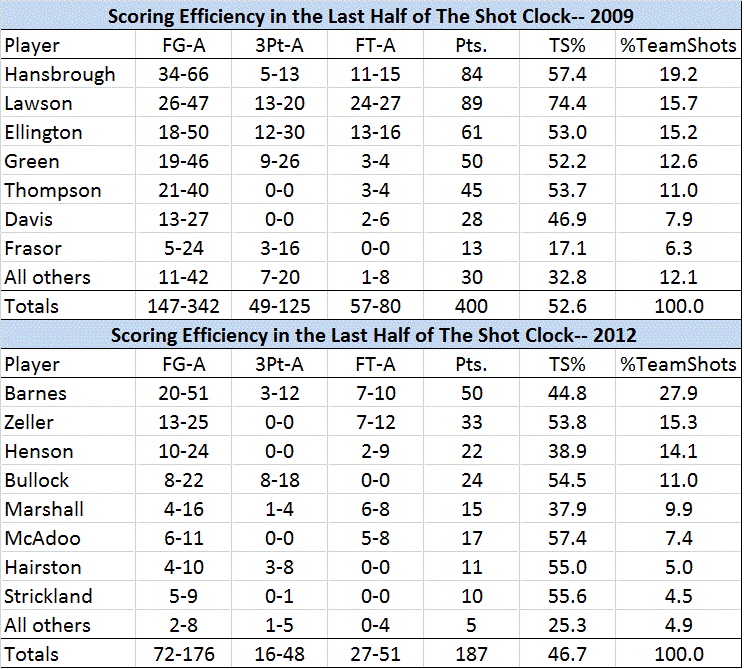North Carolina’s Late-Clock Offensive Efficiency Is A Weakness | Stat Geek Idol
March 18, 2012 - by Adrian Atkinson
***NOTE*** This is a winning Round of 64 entry from our inaugural Stat Geek Idol contest. It was conceived of and written by Adrian Atkinson of Tobacco Road Blues and HoopSpeakU. The opinions or predictions expressed below do not represent the views of TeamRankings.com, and are solely those of the author.
Conventional wisdom asserts that half-court offensive execution is an integral part of any national championship run. Assuming that this generally-accepted belief is true (it will not be empirically challenged in this piece–a topic for another Stat Geek Idol, perhaps?), does that bode trouble for the 2012 Tar Heels?
North Carolina’s half-court offensive efficiency in 2012 has paled in comparison to the 2008 and 2009 teams which featured the Tyler Hansbrough/Ty Lawson/Wayne Ellington/Danny Green core.
Specifically, these Heels have been significantly worse in the final half of the shot clock (i.e., under 18 seconds remaining in the possession) than their Lawson-led predecessors.
In the ’09 championship season, UNC’s (unadjusted) offensive efficiency was 115.6 in the last half of the clock. That team used 12.0% of its total possessions in such situations, and only 13.9% of that total resulted in turnovers. In ’12, UNC’s offensive efficiency is currently just 98.4 in the last half of the clock. These Heels let even fewer possessions (9.1%) get that deep, and turn it over on 15.3% of them.
By comparison, the ’09 and ’12 teams were very similar in terms of early-offense efficiency. ’09 UNC had an offensive efficiency of 121.9 in the first ten seconds of a possession (in 62.2% of total possessions, with a TO% of 17.3); ’12 UNC is currently at 119.1 (in 64.6% of total possessions, with a TO% of 17.8). So, while the ’09 guys were only about 2% more efficient in the early offense, they were over 17% more efficient during the final half of the shot clock.
What’s The Matter With UNC?
So what is the primary reason for this discrepancy in half-court/late-offense efficiency? As seen in the preceding paragraph, turnover rate has not been a major problem for the 2012 Heels when compared to their 2009 counterparts (both teams were terrific at avoiding turnovers—both in the early and half-court offenses). Like is often the case, the offensive inefficiency stems from a simple inability to make shots.
For both Roy Williams’ 2009 and 2012 squads, Table 1 breaks down scoring efficiency by player in these late-clock situations. The players are ranked by the percentage of the team’s weighted shots (0.475 * FTA + FGA) that each attempted in the final half of the shot clock.
A couple of things stand out immediately.
Ty Lawson was an insanely efficient scorer when the clock dipped below 18. His True Shooting Percentage (TS%) of 74.4 is easily the best among players on either team (to put it into context, the nation’s leader in that category is currently at 70.4%)—that will happen when you hit 55% from the field, 65% from behind the arc, and 89% from the line as Lawson did in those situations. His ability to break down the defense and get into the paint at will (to either finish on his own or to set up his teammates) made the 2009 Heels ruthlessly efficient in the half-court.
Harrison Barnes is responsible for 28% of UNC’s total late-clock shot attempts — nearly double the rate of the next closest 2012 Heel (Zeller at 15%). In 2009, Hansbrough led the way by taking only 19% of UNC’s weighted attempts in late-clock possessions. The ’09 team showed much more balance in the half-court, fueled by Lawson’s sublime dual-threat talents at point guard. All five starters that season had TS%’s over 50 in late-clock possessions—a testament to both how well they shot and the quality of attempts they were creating. In contrast, only Zeller (53.8) and Bullock (54.6) have TS%’s over 50 so far in 2012.
Kendall Marshall isn’t ideally suited for late-clock situations. There is no denying that Marshall is among the best passing point guards to ever play ACC basketball (and he deserves much of the credit for the late-clock scoring efficiency of catch-and-shoot guys like Bullock and Hairston, and post players like Zeller and McAdoo). But his inability to consistently break down defenders and get into the paint can hurt the Heels in expiring shot clocks. Likewise, he has not shown the ability to consistently knock down late-clock jumpers off the dribble (especially when the defender goes under a ball screen—often Carolina’s go-to set with an expiring clock). Marshall has only made 4 of 16 field goals in the final half of the clock, and his inability to create his own offense on these possessions has stymied UNC’s half-court efficiency.
Without a guy like Lawson, much of the isolation/shot creation load has fallen on the shoulders of Barnes. He is not nearly as suited for that role as Lawson, either as a scorer or (especially) as a distributor. Barnes’ penchant for taking contested mid-range shots in late-clock possessions has led to a meager TS% of 44.8. While his shot selection is not always the best in these situations, much of that is due to the burden to create that he has borne.
It is unfair to compare any Carolina point guard to the 2009 version of Ty Lawson. If not the gold standard, his junior season is clearly on the short list of greatest campaigns by a point guard in UNC’s illustrious history. But until the 2012 Heels can improve their late-clock scoring efficiency—either by Marshall striking a better pass/shoot balance, or by some other means—they might be hard-pressed to cut down the nets in New Orleans this April.
Printed from TeamRankings.com - © 2005-2024 Team Rankings, LLC. All Rights Reserved.
